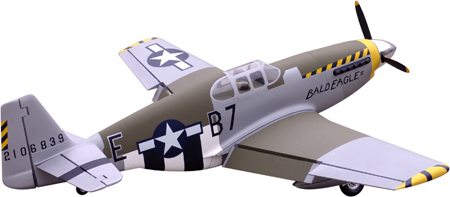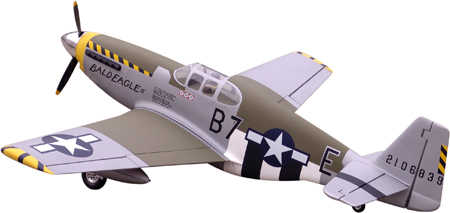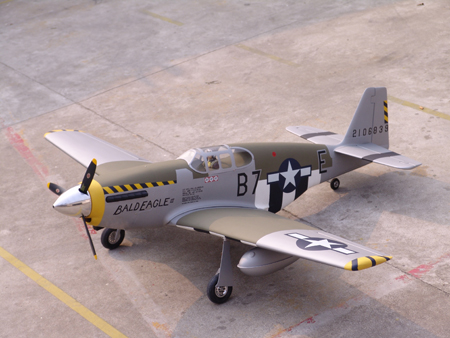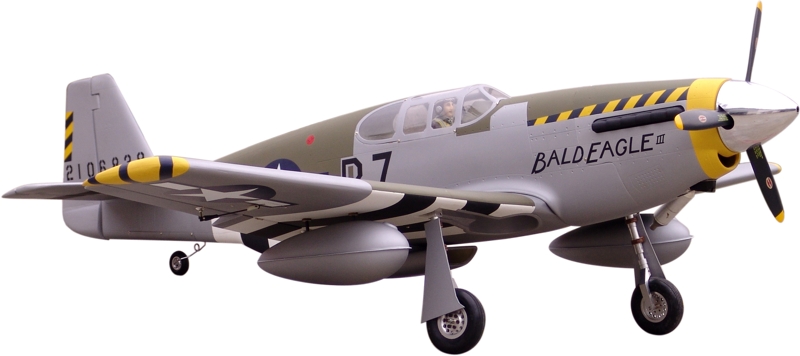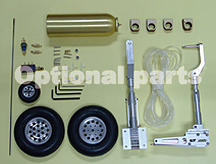Main menu
MODEL:P-51B Mustang (ITEM NO: A022)
Length: 1583mm(62.3”)
Wing span: 1800mm(71”)
Wing area: 56.7sq.dm(6.11sq.ft)
Wing loading: 100.5g/sq.dm (32.95oz/sq.ft)
Flying weight: 5.7kg(11.46lbs)
Radio: 6ch & 8servos
Engine: 120 4-cycle(108 2-cycle)
Feature:
Fiberglass fuse and balsa built-up wing
Wing Covering Material: Covering, painted, decals applied and clear coated. The aircraft has a beautiful flat, non-glossy finish. This is superior to glossy covering materials. It is scratch, tear and wrinkle resistant. The covering material is a brand name covering which has a special paint adherant layer. The covering goes on clear, and is then primed and painted, then clearcoated.
Optional:
Retractable landing gear set with oleo struts, alloy wheels. The retracts are generation 5 Air up/air down retracts, and incorporate all of the latest design improvements.
About this Model
The P-51 Mustang was the principle long range fighter in the allied arsenal. Its iconic lines and design made it one of the most recognized aircraft of the era.
The P-51 arose from a need for a fighter aircraft for the RAF in accordance with the Lend Lease Act. The British had a need for more fighter aircraft and their manufacturing plants were operating at capacity and under constant threat of bombing by the Luftwaffe. The British considered the P-40 Warhawk, but it too was being produced at capacity, and no other suitable aircraft could be found. As a result, the British contracted with North American Aviation, who also manufactured the Harvard trainer, to design and build a new aircraft, which became the Mustang.
The original Mustangs used an Allison engine which quickly was recognized as being not up to the task. The British suggested using a Rolls Royce Merlin 61 engine, whcih would drastically improve the aircraft's high altitude performance. When this proved a successful variant it was designated the P-51B and put into full scale production. With the new engine and the improved high altitude performance, and especially the more efficient fuel economy, the aircraft proved capable of providing long range escort for allied bombers. This was especially true after the introduction of tanks. It entered full service in October of 1943, and its ascendence as an escort fighter was the catalyst for an incredible reduction in the attrition rates of allied daylight bombing raids.
The P-51B was later made obsolescent by later variants, including the P-51D, but it continued to serve in ground attack and air superiority missions. The Mustang airframe continued to serve in allied airforces late into the 50's. It saw action in Korea in US hands, and a number of them also saw combat at the hands of Israeli pilots during the war of Independence in 1948 and even during the Suez crisis in 1956 (although by that time the IAF was flying mostly French jet aircraft). The last US mustang was withdrawn from service in the West Virginia ANG in 1957. In continued to serve with a variety of nations around the world, the last one being in the Dominican Republic, it was withdrawn from service in 1984. The last one lost in combat was ironically against the US. A Dominican F-51 Mustang was shot down by US forces during Operation Powerpack in 1965-66. All in all, the Mustang earned its place in history as one of the greatest military aircraft of all time.
The P-51B istened "Bald Eagle III" was flown by Lt. Robert T Eckfeldt of the 374th Fighter Squadron of the 361st Fighter Group. It was in this aircraft, on June 29th 1944, that he attacked Oschersleben aerodrome, destroying 4 FW-190's on the ground, and damaging two more. By the end of his tour in August of 1944 he had also claimed three more kills of German aircraft in the air.
Similar products
My account
About us
Tel:+30 210 5444 204 Fax: +30 210 5444 384
E-mail: info@diamond-models.gr
Working Hours: M-T-W-T-F from 9:30-20:30 Sat. from 9:30-15:00
Address: Korae 8 & Kapodestreou, Egaleo,Athens,Greece,Zip:122 41



